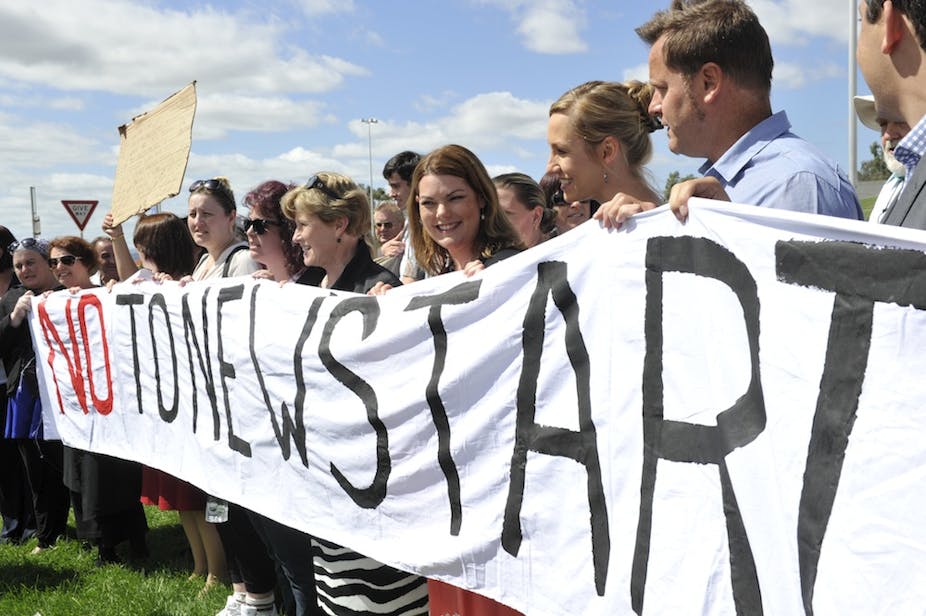Last night’s story by the ABC’s Four Corners program on the precarious plight of the unemployed gave the nation an object lesson on empathy, a salutary exposé for those who prefer to trust in sophisticated modellings rather than the bleeding obvious.
The report painted a stark picture of the inadequate nature of the Newstart income support allowance; of people depending on welfare agencies for food, experiencing insecure housing or homelessness and facing ongoing poverty and social deprivation. Notably, several of the people featured in the report were women supporting children as single parents.
According to the latest release of data from the Household, Income and Labour Dynamics in Australia (HILDA) survey, Australia’s average wealth increased between 2001 and 2010. Yet there was one group that missed out - in one-parent households, child poverty rose from 20.8% to 24.1%.
Parenting payments have always been below the poverty line – there are 879,000 sole parent households involving 2,363,000 people. If 24% live below the poverty line, that is a lot of Australian citizens. So it beggars belief that forcing families into even lower Newstart payments is good policy.
Yet there appears to be a code of silence around the issue of child poverty, dismissed as just another story for bleeding hearts. We are all better off, the argument goes, and we have a strong economy, so does this matter? Poverty has little political traction. The poor are collateral damage of market economies, the only system that works; governments cannot alter globalisation and, besides, poverty is caused by poor personal choices. Isn’t it?
It is instructive to compare the company Australia keeps with its record of child poverty and overall inequality.
Research shows Western nations have become increasingly unequal over 30 years, with consistent patterns emerging: an exponential increase in profits to the wealthiest and to corporations (rather than small businesses); a reduction in the public sector; increasing mortgage stress and homelessness; and instead of the trickle-down effect, jobless growth.
Nobel Prize economist and former World Banker, Joseph Stiglitz, explains this in The Price of Inequality as being caused by markets allowed to extract wealth from people in ways we cannot imagine. Nation states that implemented market liberalisation most assiduously - such as the USA - are most unequal. Nordic countries that maintained a mixed economy and a strong public sector are the least.
In their book The Spirit Level, epidemiologists Richard Wilkinson and Kate Pickett showed the more unequal a society is, the more it is marked by increased mental illness, illegal drug use, child and adult obesity, violence, lower aspirations in teenagers, lower maths and literacy scores, increased homicides, more conflicts between children, and increased imprisonment. The technical public health term for such societies is socially dysfunctional. In the US, 20% of adults are socially dysfunctional compared to only 5% in Sweden.
Despite its greater wealth, Australia ticks all these boxes, keeping company with the United Kingdom. In fact, Australia usually ranks second or third most unequal of the OECD’s 23 affluent democracies. Such data contravenes our sense of national identity, culture, standards of civility and our penchant for self-congratulation. This is certainly not a good look in terms of where we believe we fit internationally.
Yet the public continues to hold politically construed beliefs about the poor as basically disreputable and lazy. The Brotherhood St Laurence Life Chances longitudinal study, which tracks experiences of growing up in poverty, echoes the Four Corners program in terms of social exclusion: stressed parents and family fights, no transport to see friends, no money for school camps, sport, excursions; feeling sad because there is no money for shoes.
Research by David Zyngier from Monash University shows an increase in primary school children so discouraged that they enter high school already inwardly disengaged from social and school participation. The social and environmental conditions of poverty, if relentless and unmitigated, can constitute unacceptable risks, according to the Australian Institute of Family Studies.
Such indicators of social disadvantage are linked systematically) by the World Health Organization (WHO) to poorer health, and are all the markers of poverty.
In its report, The Solid Facts, the WHO commits itself to a definition of poverty as a self-perpetuating, mutually reinforcing dynamic. Prolonged poverty and its corollary of social exclusion have a well-proven impact in distorting the lives of entire populations and generations. Since 2000, the European Union has incorporated social policy into its central governance, while its 2020 Plan focuses on reducing poverty and social exclusion.
Yet in Australia, our governments are full throttle in the opposite direction. The focus has been on the need to “incentivise” sole parents on benefits to forego their “welfare dependency”, to acquire job-search skills and to get a job. This focus on modifying the behaviour of people, as Eva Cox reminded us, ignores the mathematics about the jobs available.
The Australian Social Inclusion Board, established in 2008 to give advice to government, lacks institutional teeth and can be easily defunded. The legislation forcing already poor sole parents on Newstart has been criticised by two bipartisan Senate Standing Committees, as well as the Parliamentary Joint Committee on Human Rights and the UN Special Rapporteur on Extreme Poverty and Human Rights.
It is not acceptable for our governments to avoid taking action to reduce poverty and social exclusion because now we know they can. Are we really happy to allow growing numbers of children to grow up in poverty? I doubt it.

